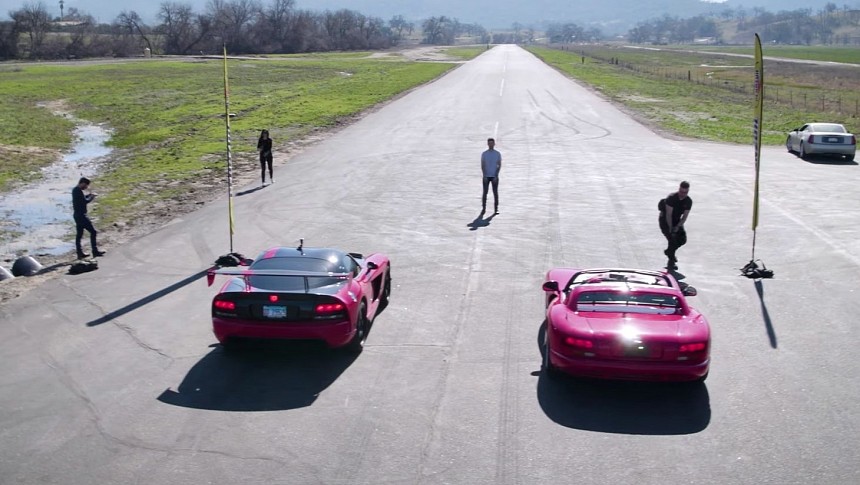If you had to choose between the original Viper and the ZB II-generation American Club Racer in the quarter mile, chances are you'd pick the newer serpent. More power, more torque, and better tires make a world of difference. So does the driver, as you'll find out from the video below. Keeping those rear tires from spinning also weighs heavily in this particular scenario, and boy, that ACR sure is hard to launch!
Over the course of four runs, of which one resulted in DNFs for both drivers, the RT/10 won twice and the American Club Racer once. It's uncannily impressive how easily that SR I scoots off into the distance, leaving the ZB II to play catch-up. The best ETs were 13 seconds flat at 113 miles per hour (182 kilometers per hour) for the original and 12.99 seconds at 123 miles per hour (198 kilometers per hour) for the newer car.
The American Club Racer also got to… uhm… race against the Ruf CTR. More than simply a tuned 911, this amazing machine features a custom five-speed manual transmission as opposed to six forward ratios for the ACR. Its twin-turbocharged boxer six-cylinder lump is a different animal from the Viper's naturally-aspirated V10 as well, and the heavier rear end of the Yellowbird helps the German sports car hook up easier. Only 29 examples were originally manufactured, and $143k was a lot of money back in 1987.
Anything between 20 to 30 other CTRs were produced from customer vehicles, namely the Carrera 3.2 of that era. From 3.4 liters, the six-pot engine of the Yellowbird reportedly produces 463 horsepower. In reality, make that 500 ponies. The second coming of the Viper ACR, by comparison, belts out a scary 600 horsepower and 560 pound-feet (760 Nm) of tire-shredding torque.
The first of three races didn't go as planned for the gentleman in the Yellowbird, who missed second gear yet finished one tenth behind the American Club Racer at a higher top speed. The second race was the best of the three in terms of ETs, with the Ruf clocking 12.1 seconds at 129 miles per hour (208 kilometers per hour) and the ACR going 12.3 at 123.5 miles per hour (199 kilometers per hour). The ACR isn't a loser, though; quite the contrary. This car was developed to corner like it's on rails, and its Nurburgring lap time of 7:22.1 stands as testament to how great the ZB II-gen ACR is on the track.
The Ruf CTR, by comparison, managed 8 minutes and 5 seconds. Then again, totally different cars from totally different eras and totally different technologies to boot. The question is, which one would you like to own between the primordial Viper, that brutal ACR, and the legendary Yellowbird?
The American Club Racer also got to… uhm… race against the Ruf CTR. More than simply a tuned 911, this amazing machine features a custom five-speed manual transmission as opposed to six forward ratios for the ACR. Its twin-turbocharged boxer six-cylinder lump is a different animal from the Viper's naturally-aspirated V10 as well, and the heavier rear end of the Yellowbird helps the German sports car hook up easier. Only 29 examples were originally manufactured, and $143k was a lot of money back in 1987.
Anything between 20 to 30 other CTRs were produced from customer vehicles, namely the Carrera 3.2 of that era. From 3.4 liters, the six-pot engine of the Yellowbird reportedly produces 463 horsepower. In reality, make that 500 ponies. The second coming of the Viper ACR, by comparison, belts out a scary 600 horsepower and 560 pound-feet (760 Nm) of tire-shredding torque.
The first of three races didn't go as planned for the gentleman in the Yellowbird, who missed second gear yet finished one tenth behind the American Club Racer at a higher top speed. The second race was the best of the three in terms of ETs, with the Ruf clocking 12.1 seconds at 129 miles per hour (208 kilometers per hour) and the ACR going 12.3 at 123.5 miles per hour (199 kilometers per hour). The ACR isn't a loser, though; quite the contrary. This car was developed to corner like it's on rails, and its Nurburgring lap time of 7:22.1 stands as testament to how great the ZB II-gen ACR is on the track.
The Ruf CTR, by comparison, managed 8 minutes and 5 seconds. Then again, totally different cars from totally different eras and totally different technologies to boot. The question is, which one would you like to own between the primordial Viper, that brutal ACR, and the legendary Yellowbird?










